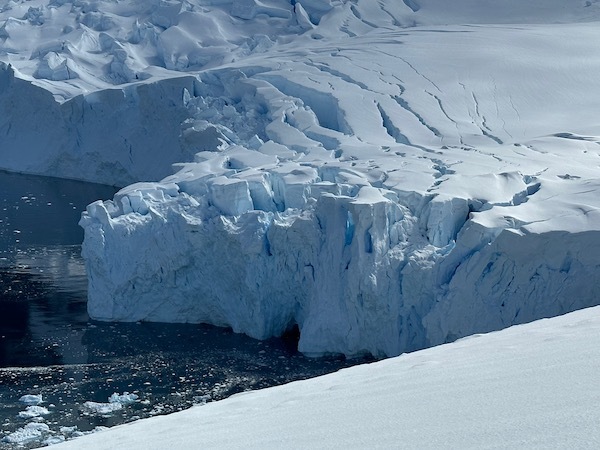Located on Andvord Bay in the Antarctic peninsula, the landing site at Neko Harbour is surrounded by glaciers. In particular, immediately to the northeast of the coordinates, the Fleiss glacier is very active, regularly calving large chunks of ice that splash thunderously into the bay below. Several viewpoints at Neko Harbor provide a fantastic view of the glacier.

Close-up of the front of the Fleiss Glacier from the coordinates
So let's learn more about glaciers, crevasses, and calving.
Definition: Glacier
A glacier is any large mass of perennial ice that originates on land by the recrystallization of snow or other forms of solid precipitation, and that shows evidence of past or present flow
How do glaciers form?
Year after year, snowflakes pile up into a deep snowpack. Soon the sheer weight of this vast accumulation presses down on itself, deforming the snowflakes beneath. The snow compresses. The fluffy flakes change to granular snow - like round ice grains - and eventually morph into solid ice. Ice near the bottom of the glacier is under tremendous pressure, which allows it to start flowing downhill over the bedrock at the bottom. It becomes a glacier.
What are the different types of glaciers?
- Ice Sheets or Ice Caps: Glaciers extending in continuous sheets, moving outward in all directions.
- Mountain or Alpine Glaciers: Glaciers confined within a path that directs the ice movement.
- Piedmont Glaciers or Ice Shelves: Glaciers that spread out on level ground or the ocean at the foot of glaciated regions
Definition: Crevasse
A crevasse is a fissure or a crack in a glacier resulting from stress produced by movement.
What are the different types of crevasses?
There are different types named according to their positions relative to the long axis of the glacier:
- Longitudinal crevasses: They develop in areas of compressive stress.
- Transverse crevasses: They develop in areas of tensile stress and are generally curved and downstream.
- Marginal crevasses: They develop when the center of the glacier moves considerably faster than the outer edges.
- Bergschrund crevasses: They develop near the head of a mountain glacier.
Many crevasses may intersect at the front of the glacier, forming jagged pinnacles of ice called seracs.

Definition: Calving
Glacier Calving is the breaking of ice chunks from the edge of a glacier. It is a form of ice ablation or ice disruption. It is often accompanied by a loud cracking or booming sound before blocks of ice break loose and crash into the water. The entry of the ice into the water causes large and often hazardous waves.
Depending on the size, the ice that breaks away can be classified into different types:
- An Iceberg - Height above water must be at least 5 m and length at least 15 m.
- A bergy bit - Height must be between 1 and 5 m, and length between 5 and 15 m.
- A growler - Height below 1 m and length below 5 m.
Earthcache questions:
To complete this earthcache, you must physically visit Neko Harbour, including going on shore and climbing to one of the two waypoints (Original coordinates or higher viewpoint) to observe the glacier from above. You need to send me by message the answer to the three questions within ten days of posting your log. You must include your picture in the log. All three questions can be answered from either of the two waypoints.
Question 1: From your observations, what type of glacier do you think Fleiss glacier is and why?
Question 2: From your observations, what type of crevasses do you see predominantly and why? Do you see any seracs? Where?
Question 3: Looking at the area close to the front of the glacier by the water, what type of floating ice do you see (icebergs, bergy bits, or growlers)?
Requirement 4: Post a picture of yourself or your GPS with the glacier in the background from one of the waypoints.
Enjoy your visit to the fantastic Neko Harbour! And let me know in your log how many calving events you heard or saw while you were at Neko Harbour.
Reference: